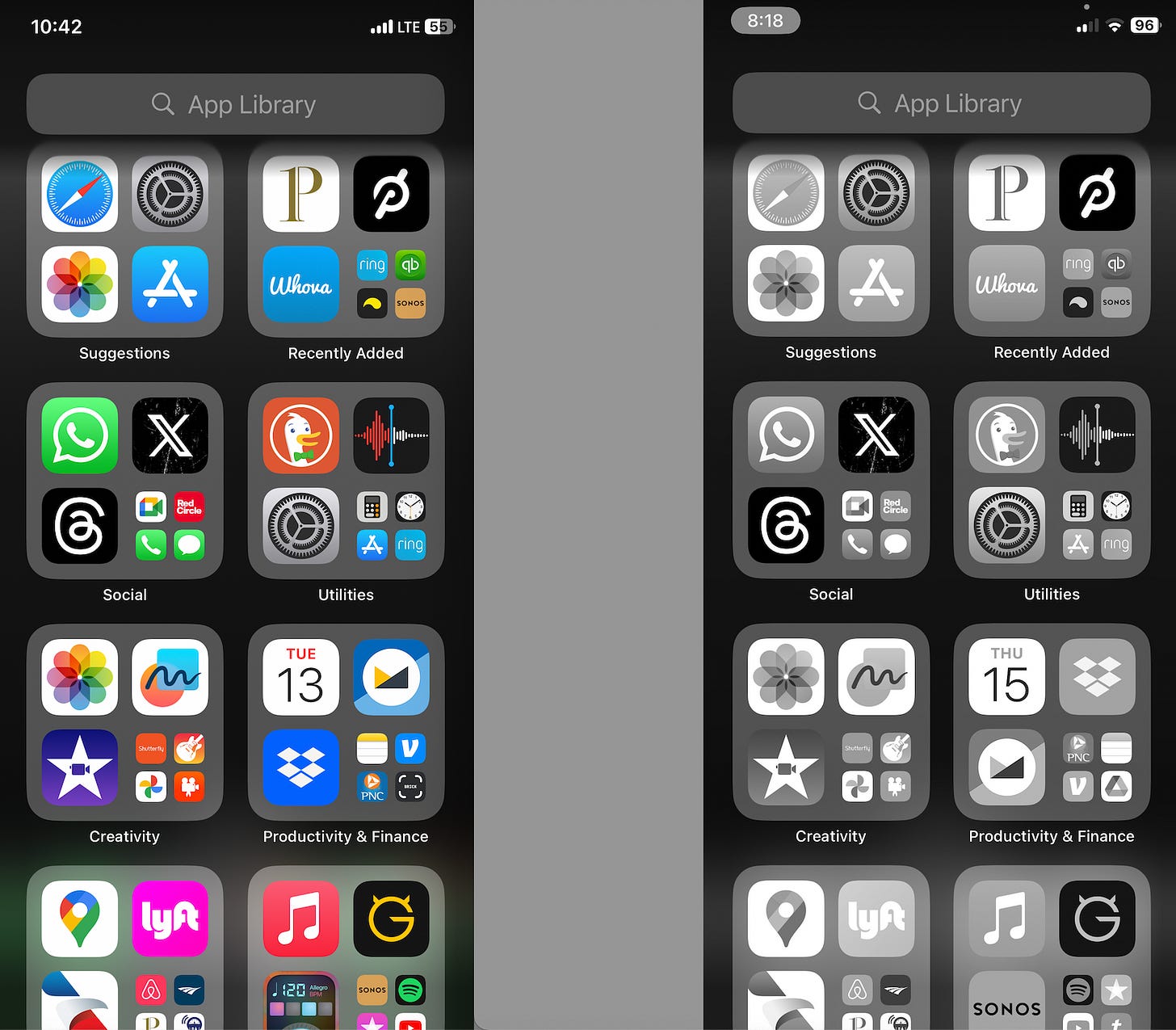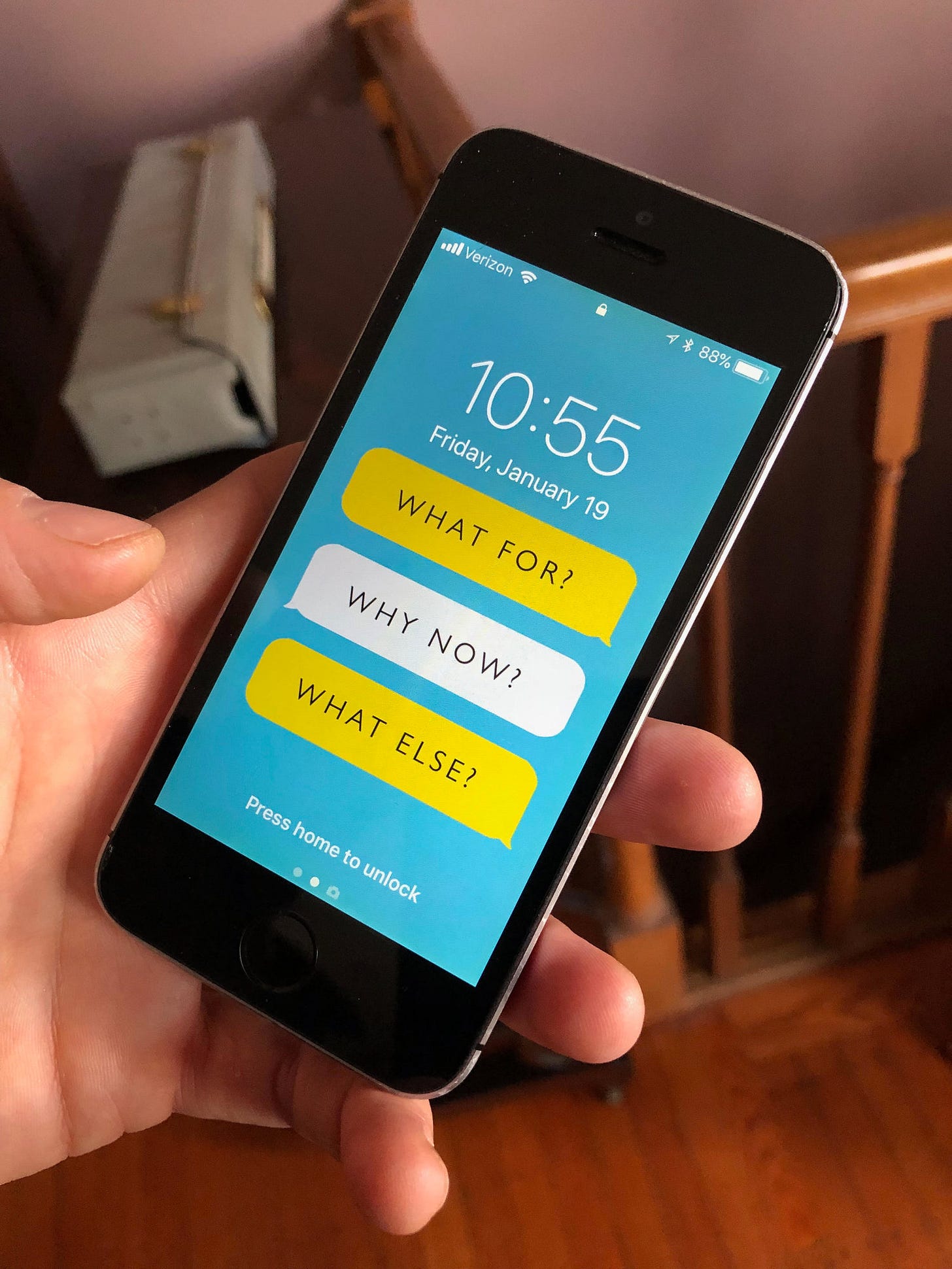How I turned my smartphone into a dumb phone
And how you can, too
First of all, an apology to all the “dumb” phones out there: you are not dumb; you are actually way smarter than “smart” phones. It’s a misnomer, kind of how Apple’s new Vision Pro ski goggles are being marketed as “augmented” reality when in fact, they diminish it, and seem likely to lead to a Wall-E-esque future where each person exists in their own virtual bubble, physically present but in all other ways completely detached from life.
But I digress.
Today, I wanted to share with you a few concrete things I’ve done to my own phone to transform it from a temptation to a tool. (In my next newsletter, I’ll introduce you to some of my favorite apps and products that can make setting boundaries even easier.)
Before we start, a quick reminder/invitation to Fun Squad members to keep asking questions and participating in the Phone Breakup Forum—I read them all, and will respond personally to each one.
ALSO (and very importantly), I started the entire process not by trying to restrict my phone use, but instead by asking myself, “What do I want to pay attention to?”
By proactively identifying what is important to me, I shifted my phone from a temptation that I try to resist, to an obstacle that (while enjoyable and in some ways essential) often gets in the way of how I want to be living my own life.
With that philosophical framework in place, here are some of the changes I made.
1. I turned my phone to black and white
You may have heard this tip before, but you may not know why it’s so effective.
To understand, first, check out the two screens below. Stare at the one on the left, and then the one on the right, and notice how it feels in your brain and body.
If you’re like me, you’ll notice a palpable difference: the one on the left feels viscerally attractive, and gives me a feeling of openness and curiosity. The one on the right, on the other hand, feels unappealing and boring, and makes me feel a little trapped—all effects that I would not want from a human relationship, but that are exactly what I want when it comes to my phone.
The screen on the left is viscerally appealing because bright colors trigger the release of dopamine, a chemical that our brains use to record when something is worth paying attention to and seeking out. Like, for example, the sight of a ripe, red strawberry standing out in contrast to the green leaves around it.
Natural dopamine triggers, like strawberries, usually don’t cause problems. But there’s nothing natural about the dopamine triggers that are baked into our phones or apps. Instead, they’ve been deliberately placed there by engineers. The goal? To manipulate our brains (via dopamine) into tagging our phones and apps as “important” and, in so doing, to motivate us to check them again and again.
Take, for example, the red of notification badges:
It’s basically the same red as a ripe strawberry (i.e. a natural dopamine trigger), which is also the same red of other eye-catching things that we are hardwired to notice and pay attention to, such as stop signs . . . and blood.
Same deal with things like the vibrant pink of the Instagram logo: those colors are deliberately chosen to pull us in.
That’s why I turned my phone to black and white. But I also did something else really important, which was . . .
2. I made it easy to toggle between color and black and white
I know that some of you have already experimented with turning your screen to black and white, and you probably found it useful, and yet somehow, as you are reading this, your screen is color again.
That’s because at some point, you realized you wanted/needed to see something in color (a map, a photo, etc) and you burrowed into your phone’s settings and changed it back to color and it was JUST annoying enough to ensure that you forgot to turn it to black and white again.
The solution (on an iPhone) is go to into settings>accessibility>accessibility shortcuts>color filters and enable color filters (you’ll see a check mark next to it). Then, when you triple click the right side button, your phone’s screen will toggle between color and black and white, no settings burrowing required. (See below for a video of me demonstrating how to do this on my own phone, and here are instructions for doing something similar on Android.) This makes it extremely easy to turn your phone to black and white, which means you’re more likely to do it.
3. I deleted the apps that I knew were problems for me
If you’re trying to quit smoking, it’d be pretty dumb to carry a pack of cigarettes around in your pocket. The same is true for apps on our phones: if you know that Instagram is a problem for you, why is it on your home screen? Or, for that matter, on your phone at all?
My own biggest “problem apps” were email and the news. So about four years ago, I deleted both, and have never looked back. This doesn’t mean that I never check email or the news from my phone—I just do it through the internet browser. This makes it just annoying enough to make it less likely for me to check them on autopilot or because of an impulse.
If you’re saying, “Well, I couldn’t possibly delete ____,” ask yourself, “Is that really true?” Then experiment with just doing it until tomorrow (or even just a few hours) and then see whether the sky actually fell because you didn’t check your work email for an evening.
Also, you can always have what I call an “on-again, off-again” relationship, where you keep apps off your phone most of the time and simply reinstall them when you need/want to use them and delete them again afterwards.
Pro tip:
In general, if you’re trying to change a habit, you want to add friction to the behavior you’re trying to cut back on, and reduce friction for the behaviors you’re trying to spend more time on. That’s why I also recommend getting your phone out of your bedroom and putting something on your bedside table that you want to spend time on instead, like a book or a journal or a project.
4. I turned off nearly all notifications interruptions
I call “notifications” “interruptions” because that’s what they actually are: interruptions that pull you out of your actual life and toward your phone. So ask yourself: what’s worth being interrupted for? What’s allowed to interrupt a conversation with a friend or colleague? What’s worth being interrupted for during your child’s bedtime story? (Actually, please try not to have your phone with you during your child’s bedtime story!)
I personally only allow notifications for phone calls, text messages, calendar reminders and navigation alerts. You do you, but keep it to a minimum; you can always turn them back on.
5. I took the photo of my family off the home/lock screen
As you may have noticed, there’s no photo on my home screen — same is true for my lock screen. I do that because I don’t want to conflate staring at a photo of my family or friends on my phone with spending time with them in real life. I recognize that some people (such as my friend/tech columnist Kevin Roose) enjoy using photos on their phones specifically to spark delight (a noble reason, in my opinion) but for me personally, I’ve concluded that boring is better. I also occasionally use one of these reminder images I created, which I’ll include below for Fun Squad members. (Thanks, Fun Squad!)








